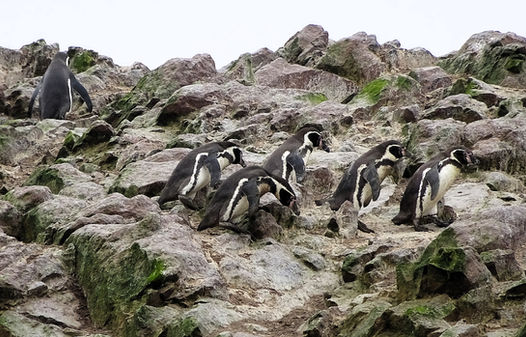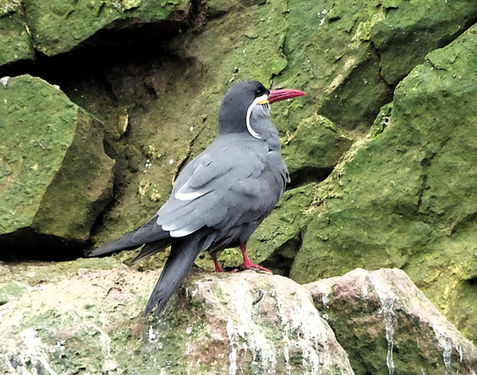
Paracas
Peru
Paracas was a shock for us. I'm not sure what we were expecting, but a sleepy seaside town with restaurants and bars lining the shore was a nice surprise. The laid back vibe and glowing sunsets had us loving the place instantly. The only downside were the touts, who didn't give us a minute's peace. Whether it was for tours or food, we were accosted relentlessly whenever we walked anywhere. It was exhausting.
In the morning we hired mountain bikes and set off for Paracas National Reserve. Even though I had been told we would be riding through the desert, I wasn’t expecting it to be so beautiful. The short golden sand dunes contrasted sharply to the deep blue of the ocean, and every lookout offered something unique. Riding through the reserve was challenging to say the least: cracked and potholed paths and roads, undulating hills that felt like mountains, plus a fierce headwind that had us cursing under our breath, but it was well worth the effort.
First stop was Playa Supay, where the cliff dropped dramatically down towards the ocean. It was reminiscent of an Australian coastline, and nothing like we had seen in South America so far. Nearby was the viewpoint for La Catedral, a rock formation that used to be connected to the mainland, but an earthquake in 2007 destroyed the natural bridge between the two. What was left was just a jagged rock sitting by itself the middle of the ocean, but it still added to the scenic landscape.
The empty Playa Yumaque was a wide flat expanse of sand that blended into the background. It was hard to tell where the desert stopped and the beach started. Further up the road was Mirador Istmo, which seemed a bit pointless because there was nothing to see from here except sand. On the opposite side of the road was a path leading up to a viewpoint that wasn’t on our map, which offered a spectacular view over Playa Roja. A thick strip of deep red sand sat between the aquamarine water and the yellow desert, creating a striking image. It was the best lookout we visited all day and it wasn't even signposted.
Playa Roja also looked incredible down below, where again there was a clear distinction between the vibrant colours of the landscape. Entry to the beach was forbidden in an effort to protect the natural wonder, which was perfect for taking photos but disappointing not to see it up close.
The next stop was Lagunillas, a tiny fishing village consisting of just a handful of restaurants and dozens of small boats in the harbour. I was keen to visit the beaches further along the coast, but Danny took one look at the hill we needed to climb combined with the fierce headwind and decided he wasn't going anywhere. He stopped at Lagunillas to eat lunch while I braved the gusts, not managing to cycle faster than walking pace. I made it up and over the crest then down the other side, which took me to Playas La Mina and El Raspon. Mina was tiny but full of people, and the most suitable beach for swimming in the area. There were a few people further around at El Raspon, but clearly La Mina was the place to be.
The return trip back to Danny over the hill was much more bearable with a tailwind, as was the ride back to Paracas. It also helped that half the journey was on a smooth, paved road, even with the trucks continuously zooming past us. In the end it had been a fantastic day out, cycling 44 km around the reserve, and we appreciated exploring an area completely different to anywhere else we had visited in Peru.

A light drizzle was falling on the morning of our boat trip to the Ballestas Islands, which wasn't ideal. Our boat had a roof, unlike some of the others we passed, but it didn't stop the rain and cold winds from blowing in through the open-air sides. I immediately wished I had brought more layers with me.
Only 2 minutes after leaving the port we noticed a couple of dolphins swimming beside us. The guide informed us that dolphins sightings weren't guaranteed, so seeing them, even for just a minute or so, was a good start to the trip.
On the way to the islands we stopped to admire a prehistoric petroglyph known as the Candelabra. The image was carved into the side of a red-tinged mountain in roughly 200 BCE and was a whopping 180 metres high. Who created it and why, and what it was actually supposed to represent, was anybody's guess.
The Ballestas Islands are a series of rocks that are home to a wide variety of bird and marine life. The boat wound its way around the edges of the rocky mounds, searching for the most popular animals. Almost immediately we spotted Humboldt penguins, native to only Peru and Chile, congregating in small groups high up on the rocks. Our guide reeled off a bunch of facts about birds and the islands in general, but I don’t think anyone was listening as the penguins commanded all of our attention. They were extremely cute - it was a pity we couldn’t see them close up.
Any bird lovers on board were in luck. I couldn't remember half of the breeds the guide pointed out to us, but some of the species we were fortunate enough to see included pelicans, vultures and a black oystercatcher with a distinctive red beak. The Peruvian boobies didn't have the coloured feet of the Galapagos varieties, but the Inca tern sported an impressive moustache that quickly made it my favourite sighting of the day. There were also vibrant Red Rock Crabs lounging on the rocks, while starfish sat just below the water’s surface.
Finally we arrived at the animals we all longed to see: the sea lions. We had noticed their heads bobbing up and down near the boat on the way over, but here we could watch them sunbathing on the rocks and jumping theatrically in and out of the water. Later on we came across the biggest sea lion I had ever seen in my life. Not only was he massive in size but he also sported a mane, which added to his bulk. Just as we pulled up he started mating with a much more petite sea lion, who was unfortunately underneath. I don't know how she wasn't squashed flat.
After what felt like a very short amount of time, we were on our way back to the mainland. I wished we had spent longer observing the various animals, but I couldn't deny that I was looking forward to escaping the cold and wet conditions and putting on a few more layers of clothing.










































